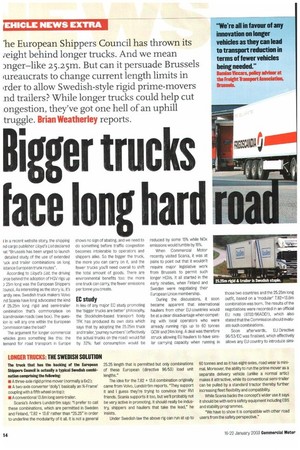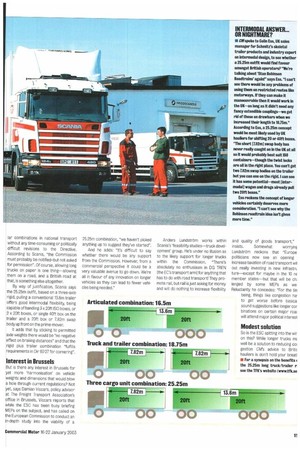Bigger trucks lace Ions hard
Page 14

Page 15

If you've noticed an error in this article please click here to report it so we can fix it.
lie European Shippers Council has thrown its /eight behind longer trucks. And we mean mger—like 25.25m. But can it persuade Brussels lureaucrats to change current length limits in irder to allow Swedish-style rigid prime-movers nd trailers? While longer trucks could help cut ongestion, they've got one hell of an uphill truggle. Brian Weatherley reports.
i In a recent website story, the shipping nd cargo publisher Lloyd's List declared tat "Brussels has been urged to launch detailed study of the use of extended -uck and trailer combinations on long istance European trunk routes".
According to Lloyd's List, the driving rce behind the adoption of HGV rigs up
25m long was the European Shippers ;ouncil. As interesting as the story is, it's ardly new. Swedish truck makers Volvo .nd Scania have long advocated the kind if 25.25m long rigid and semi-trailer ombination that's commonplace on lcandinavian roads (see box). The quesion is: will any one within the European ;ommission take the bait?
The argument for longer commercial ,ehicles goes something like this: the iemand for road transport in Europe
shows no sign of abating, and we need to do something before traffic congestion becomes intolerable to operators and shippers alike. So the bigger the truck, the more you can carry on it, and the fewer trucks you'll need overall to shift the total amount of goods. There are environmental benefits too: the more one truck can carry, the fewer emissions per tonne you create.
EC study
In lieu of any major EC study promoting the 'bigger trucks are better' philosophy, the Stockholm-based transport body TFK has produced its own data which says that by adopting the 25.25m truck and trailer, 'journey numbers' (effectively the actual trucks on the road) would fall by 32%; fuel consumption would be reduced by some 15% while NOx emissions would tumble by 15%.
When Commercial Motor recently visited Scania, it was at pains to point out that it wouldn't require major legislative work from Brussels to permit such longer HGVs. It all started in the early nineties, when Finland and Sweden were negotiating their European Union membership.
During the discussions, it soon became apparent that international hauliers from other EU countries would be at a clear disadvantage when competing with local operators who were already running rigs up to 60 tonnes GCW and 24m long. A deal was therefore struck allowing EU hauliers to have similar carrying capacity when running in those two countries and the 25.25m long outfit, based on a 'modular' 7.82+13.6m combination was born. The results of the negotiations were recorded in an official Ell note (8702/96ADD1), which also stated that the Commission should evaluate such combinations.
Soon afterwards, EU Directive 96/53/EC was finalised, which effectively allows any EU country to introduce simi lar combinations in national transport without any time-consuming or politically difficult revisions to the Directive. According to Scania, The Commission must probably be notified—but not asked for permission". Of course, allowing long trucks on paper is one thing—allowing them on a road, and a British road at that, is something else altogether.
By way of justification, Scania says the 25.25m outfit, based on a three-axle rigid, pulling a conventional 13.6m trailer offers good intermodal flexibility, being capable of handling 3 x 2Crft ISO boxes, or 2 x 20ft boxes, or single 40ft box on the trailer and a 20ft box or 7.82m swap body up front on the prime-mover.
It adds that by sticking to permitted axle weights there would be "no negative effect on braking distances" and that the rigid plus trailer combination "fulfills requirements in Dir 97/27 for cornering".
Interest in Brussels
But is there any interest in Brussels for yet more 'harmonisation' on vehicle weights and dimensions that would blow a hole through current regulations? Not yet, says Damian Viccars, policy advisor at The Freight Transport Association's office in Brussels. Viccars reports that while the ESC has been busy briefing MEPs on the subject, and has called on the European Commission to conduct an in-depth study into the viability of a 25.25m combination, "we haven't picked anything up to suggest they've started".
And he adds: 'It's difficult to say whether there would be any support from the Commission. However, from a commercial perspective it could be a very valuable avenue to go down. We're all in favour of any innovation on longer vehicles as they can lead to fewer vehicles being needed." Anders LundstrOm works within Scania's 'feasibility studies—truck development' group. He's under no illusion as to the likely support for longer trucks within the Commission. "There's absolutely no enthusiasm in DG TREN [the EC's transport arm] for anything that has to do with road transport! They promote rail, but rail is just asking for money and will do nothing to increase flexibility and quality of goods transport,"
insists. Somewhat worryini LundstrOm reckons that "Europe politicians now see an opening increase taxation of road transport wit out really investing in new infrastrt ture—except for maybe in the 10 ni member states—but that will be chi lenged by some MEPs as we Reluctantly he concedes: 'For the tin
being, things like congestion ha to get worse before basica sound suggestions like longer cor binations on certain major max will attend major political interest
Modest solution
So is the ESC spitting into the wir on this? While longer trucks mr well be a solution to reducing coi gestion CMs advice to Briti.E hauliers is don't hold your breat
• For a synopsis on the benefits I the 25.25m long truck/trailer r see the TFWs website (www.tfk.se




























































































































































